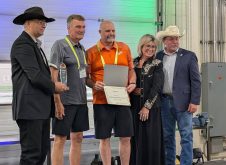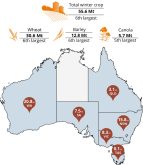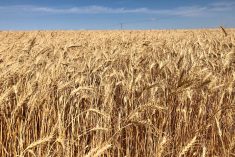Harvest weed-seed control takes aim at reducing herbicide-resistant weeds that western Canadian farmers find more and more every year.
At the Ag in Motion outdoor farm show this week, field residue management manufacturer Redekop won the Innovations Award for Environmental Sustainability for its harvest Seed Control Unit, which destroys more than 95 per cent of unwanted seeds the combine leaves behind.
With different weeds and weed varieties becoming increasingly resistant to glyphosate herbicides, integrated weed management will be vital for western Canadian farmers in the near future.
Read Also

Claas Axion 9.450 tractor wins ‘Tractor of the Year’ at Agritechnica 2025
On opening day of Agritechnica 2025, Claas’ Axion 9.450 Terra Trac tractor was awarded ‘Tractor of the Year’ for 2026 in the HighPower category.
Redekop field support and salesperson Neale Heinrich was at the Discovery Farm for this year’s Ag in Motion event, coming from Australia. The battle with herbicide-resistant weeds Down Under has spanned decades, particularly against Italian ryegrass.
“We’re close to 40 years of resistance, building and building,” said Heinrich.
“It’s been a battle. All sorts of different processors, chaff carts, burning, all sorts of stuff.”
There are many different ways to control weed seeds at harvest, such as chaff-collecting, chaff-trampling, chaff-lining, baling behind the combine and burning the straw.
Some methods remove the chaff, and in turn remove most of the seeds with it. Chaff-trampling and chaff-lining concentrate the chaff into lines, which create rot and make it difficult for the weeds to grow while reducing their spread.
The Redekop Seed Control Unit destroys the seeds that leave the combine through the chaff and spreads a refined dust across the field, removing the seed problem without removing the straw.
Managing the chaff is key to eliminating herbicide-resistant weeds because they are typically spread through the combine’s straw chopper, broadcasting the seeds across the field.

Breanne Tidemann, a research scientist at Agriculture and Agri-Food Canada, wants to find ways to limit how many weed seeds remain in the field after harvest, and in turn limit weed growth and reproduction.
“When we’re applying herbicides, we’re trying to stop those seedling stages,” she said.
“we’re focusing on that part of the life-cycle — let’s kill those seedlings. But those seedlings we don’t manage to kill, those that return, the ones that produce the seeds that we’re broadcasting, those that are a problem in the current system, they’re probably the most herbicide-resistant.
“They’re the ones that have avoided every other thing that we’ve thrown at them so far, and they’re going to come back and grow again next year. We’re making our lives harder by putting those back into our soil.”
Tidemann specializes in integrated weed management, weed biology, harvest weed-seed control and managing herbicide-resistant weeds. She spoke at Ag in Motion Tuesday on herbicide-resistant weeds in Western Canada and how to manage them.
Wild oats, kochia, cleavers and green and yellow foxtail are some of the many weeds becoming resistant to herbicides across the Prairies.
Tidemann’s research shows that 74 per cent of any weed that is put through the harvester will be herbicide-resistant, and so will their seeds.
“Three out of four fields that have weeds in them around harvest time probably have resistant weeds,” said Tidemann.

The number is also increasingly rapidly. Her studies show that kochia in Alberta was first observed as being glyphosate-resistant in 2011, and in 2012 five per cent of populations were resistant.
In the most recent 2021 survey, 78 per cent of kochia in Alberta is resistant. The resistance is growing in population and in strength, making more herbicides useless against them.
For Heinrich, this sounded all too familiar.
“Listening to Breanne (Tidemann), you want to get on it,” he said.
“If you can learn anything from Australia’s perspective, we’re fighting, we’re fighting back and working our hardest to try to get ahead of it, but it’s been ahead of us.”
Taking the seeds out of the field helps Australian farmers regain control of their farmland, although Heinrich said it took them a long time for the seed banks to empty.
Newcomers to integrated seed management can’t expect weeds to leave the field instantly, although they can expect to see their weeds stay more concentrated rather than spread across the field.
“It’s a long-term (plan),” said Heinrich. “We do have clients that have said they’ve taken on a piece of property and it was filthy with weeds when they took it, then the following year they came back to harvest and they’ve seen a marked difference.”
While integrated weed management has been widely adopted in Australia, it has not gained a lot of traction in Western Canada. Tidemann said only 20 to 30 Redekop Seed Control Units are being used across the Prairies.














